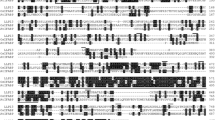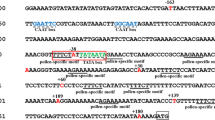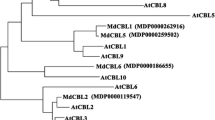Abstract
LIM proteins are important eucaryotic developmental regulators characterized by the presence of one or several double zinc finger motifs, the LIM domains, which are protein-interacting domains. Using the cDNA of the previously described pollen LIM protein PLIM1 from sunflower as a hybridization probe we have isolated the coding sequence for a related protein from cDNA libraries from various sunflower organs. This protein, WLIM1, is 188 amino acids long and, like the pollen protein PLIM1, contains two LIM domains, separated by a 48 residue spacer region. The two sunflower proteins are structurally related to the animal LIM proteins CRP and MLP. A WLIM1 gene transcript was detected by RT-PCR in all vegetative and reproductive plant organs tested. Polyclonal antibodies raised against the bacterially expressed and affinity-purified protein recognize a polypeptide of ca. 50 kDa in these organs. Immunocytochemical studies detect the protein in many cell types in each of these organs where it is localized either to the cytoplasm, the nucleus, or both. The protein is often associated with plastids and smaller cellular structures or organelles. In late anaphase and early telophase of dividing cells from ovaries, stems and roots it accumulates in the phragmoplast, and may therefore also play a role in cytokinesis.
Similar content being viewed by others
References
Arber, S. and Caroni, P. 1996. Specificity of single LIM motifs in targeting and LIM/LIM interactions in situ. Gene Devel. 10: 289–300.
Arber, S., Halder, G. and Caroni, P. 1994. Muscle LIM protein, a novel essential regulator of myogenesis, promotes myogenic differentiation. Cell 79: 221–231.
Arber, S., Hunter, J.J., Ross, J. Jr., Hongo, M., Sansig, G., Borg, J., Perriard, J.C., Chien, K.R. and Caroni, P. 1997. MLPdeficient mice exhibit a disruption of cardiac cytoarchitectural organization, dilated cardiomyopathy, and heart failure. Cell 88: 393–403.
Arber, S., Barbayannis, F.A., Hanser, H., Schneider, C., Stanyon, C.A., Bernard, O. and Caroni, P. 1998. Regulation of actin dynamics through phosphorylation of cofilin by LIM-kinase. Nature 393: 805–809.
Baltz, R., Domon, C., Pillay, D.T.N. and Steinmetz, A. 1992a. Characterization of a pollen-specific cDNA from sunflower encoding a zinc finger protein. Plant J. 2: 713–721.
Baltz, R., Evrard, J.L., Domon, C. and Steinmetz, A. 1992b. A LIM motif is present in a pollen specific protein. Plant Cell 4: 1465–1466.
Baltz, R., Evrard, J.L., Bourdon, V. and Steinmetz, A. 1996. The pollen-specific LIM protein PLIM-1 from sunflower binds nucleic acids in vitro. Sex. Plant Reprod. 9: 264–268.
Baltz, R., Schmit, A.C., Kohnen, M., Hentges, F. and Steinmetz, A. 1999. Differential localization of the LIMdomain protein PLIM-1 in microspores and mature pollen grains from sunflower. Sex. Plant Reprod. 12: 60–65.
Chomczynski, P. and Sacchi, N. 1987. Single-step method of RNA isolation by acid guanidium thiocyanate-phenol-chloroform extraction. Anal. Biochem. 162: 156–159.
Dawid, I.B., Toyama, R. and Taira, M. 1995. LIM domain proteins. C.R. Acad. Sci. [III] 318: 295–306.
Eliasson, Å., Gass, N. and Steinmetz, A. 1999. Functional studies of PLIM-1, a pollen-specific protein. In: C. Clément, E. Pacini and J.C. Audran (Eds.), Anther and Pollen: From Biology to Biotechnology, Springer-Verlag, Berlin, pp. 139–148.
Flick, M.J., Kudla, A.J. and Konieczny, S.F. 1997. MLP expression and protein interactions in the developing heart. Mol. Biol. Cell 8: 376a.
Freydt, G., Kim, S.K. and Horvitz, H.R. 1990. Novel cysteine-rich motif and homeodomain in the product of the Caenorhabditis elegans cell lineage gene lin-11. Nature 344: 876–879.
Harlow, E. and Lane, D. 1988. Antibodies: A Laboratory Manual, Cold Spring Harbor Laboratory, Cold Spring Harbor, NY. 302
Jurata, L.W., Pfaff, S.L. and Gill, G.N. 1998. The nuclear LIM domain interactor NLI mediates homo-and heterodimerization of LIM domain transcription factors. J. Biol. Chem. 273: 3152–3157.
Karlsson, O., Thor, S., Norberg, T., Ohlsson, H. and Edlund, T. 1990. Insulin gene enhancer binding protein Isl-1 is a member of a novel class of proteins containing both a homeo-and a Cys-His domain. Nature 344: 879–882.
Kong, Y.F., Flick, M.J., Kudla, A.J. and Konieczny, S.F. 1997. Muscle LIM protein promotes myogenesis by enhancing the activity of MyoD. Mol. Cell. Biol. 17: 4750–4760.
Louis, H.A., Pino, J.D., Schmeichel, K.L., Pomiè s, P. and Beckerle, M.C. 1997. Comparison of three members of the cysteine-rich protein family reveals functional conservation and divergent patterns of gene expression. J. Biol. Chem. 272: 27484–27491.
Palevitz, B.A. and Hepler, P.K. 1975. Identification of actin in situ at the ectoplasm-endoplasm interface of Nitella. J. Cell. Biol. 65: 29–38.
Pomiè s, P., Louis, H.A. and Beckerle, M.C. 1997. CRP1, a LIM domain protein implicated in muscle differentiation, interacts with alpha-actinin. J. Cell. Biol. 139: 157–168.
Sadler, L., Crawford, A.W., Michelsen, J.W. and Beckerle, M.C. 1992. Zyxin and cCRP: two interactive LIM domain proteins associated with the cytoskeleton. J. Cell. Biol. 119: 1573–1587.
Schmeichel, K.L. and Beckerle, M.C. 1994. The LIM domain is a modular protein-binding interface. Cell 79: 211–219.
Taira, M., Evrard, J.L., Steinmetz, A. and Dawid, I.B. 1995. Classification of LIM proteins. Trends Genet. 11: 431–432.
Takahashi, K. and Hattori, A. 1989. Alpha-actinin is a component of the Z-filament, a structural backbone of skeletal muscle Z-disks. J. Biochem. (Tokyo) 105: 529–536.
Wadman, I.A., Osada, H., Grutz, G.G., Agulnick, A.D., Westphal, H., Forster, A. and Rabbitts, T.H. 1997. The LIM-only protein Lmo2 is a bridging molecule assembling an erythroid, DNAbinding complex which includes the TAL1, E47, GATA-1 and Ldb1/NLI proteins. EMBO J. 16: 3145–3157.
Way, J.C. and Chalfie, M. 1988. mec-3, a homeobox-containing gene that specifies differentiation of the touch receptor neurons in C. elegans. Cell 54: 5–16.
Yang, N., Higuchi, O., Ohashi, K., Nagata, K., Wada, A., Kangawa, K., Nishida, E. and Mizuno, K. 1998. Cofilin phosphorylation by LIM-kinase 1 and its role in Rac-mediated actin reorganization. Nature 393: 809–812.
Author information
Authors and Affiliations
Rights and permissions
About this article
Cite this article
Mundel, C., Baltz, R., Eliasson, Å. et al. A LIM-domain protein from sunflower is localized to the cytoplasm and/or nucleus in a wide variety of tissues and is associated with the phragmoplast in dividing cells. Plant Mol Biol 42, 291–302 (2000). https://doi.org/10.1023/A:1006333611189
Issue Date:
DOI: https://doi.org/10.1023/A:1006333611189




